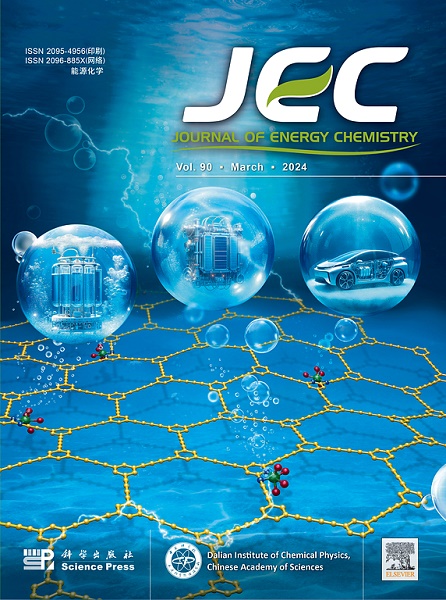New insights into the long-range interaction mechanism of nitrogen reduction
IF 13.1
1区 化学
Q1 Energy
引用次数: 0
Abstract
Catalysts with asymmetric coordination exhibit excellent electrocatalytic activity due to changes in the active sites, which affect the arrangement of reactants and catalytic activity/selectivity. Hence, the exploration of the inherent characteristics of active sites within diverse coordination environments holds great significance for the experimental design of catalytic structures. Single-atom catalysts (SACs) characterized by high coordination with four carbons (26 candidates) and low coordination with dinitrogen (27 candidates) are constructed using nitrogen-doped graphdiyne derivatives (NGDY) as the substrate. Additionally, 5 species of dual-atom catalysts (DACs) with coexistence of both high and low coordination sites are also developed and their nitrogen reduction reaction (NRR) activities are systematically investigated by density functional theory. The results indicate that metals with low coordination exhibit superior catalytic performance, such as MoL-NGDY (UL = −0.30 V) and NbL-NGDY (UL = −0.32 V). Furthermore, machine learning (ML) methods have deeply analyzed and elucidated the primary intrinsic characteristics that influence catalytic performance. These results not only unveil the underlying mechanisms behind the exceptional catalytic performance exhibited by low-coordination metal atoms, but also provide relevant and significant descriptors. More importantly, based on an investigation of the catalytic activity of a series of DACs, the “buffer and low-coordination accumulate” asymmetric coordination mechanism is proposed to unveil the long-range interactions between low and high coordination atoms. Due to this remote communication, MoNb-NGDY (UL = −0.09/−0.37 V) exhibits the best NRR activity. This mechanism provides valuable insights into the origin of long-range bipartite interactions and inspires the design and synthesis of NRR catalysts with different coordination environments.

氮还原远程相互作用机制的新认识
具有不对称配位的催化剂由于活性位点的改变而表现出优异的电催化活性,从而影响了反应物的排列和催化活性/选择性。因此,探索不同配位环境下活性位点的固有特征对催化结构的实验设计具有重要意义。以氮掺杂石墨烯衍生物(NGDY)为底物,构建了与4个碳(26个候选)高配位和与二氮(27个候选)低配位的单原子催化剂(SACs)。此外,还开发了5种高、低配位共存的双原子催化剂(dac),并利用密度泛函理论对其氮还原反应(NRR)活性进行了系统研究。结果表明,低配位金属MoL-NGDY (UL = - 0.30 V)和NbL-NGDY (UL = - 0.32 V)表现出优异的催化性能。此外,机器学习(ML)方法深入分析和阐明了影响催化性能的主要内在特征。这些结果不仅揭示了低配位金属原子表现出的特殊催化性能背后的潜在机制,而且提供了相关的和重要的描述符。更重要的是,通过对一系列dac催化活性的研究,提出了“缓冲-低配位积累”的不对称配位机制,揭示了低配位原子与高配位原子之间的远程相互作用。由于这种远程通信,MoNb-NGDY (UL =−0.09/−0.37 V)表现出最好的NRR活性。这一机制为研究远程二部相互作用的起源提供了有价值的见解,并为设计和合成具有不同配位环境的NRR催化剂提供了灵感。
本文章由计算机程序翻译,如有差异,请以英文原文为准。
求助全文
约1分钟内获得全文
求助全文
来源期刊

Journal of Energy Chemistry
CHEMISTRY, APPLIED-CHEMISTRY, PHYSICAL
CiteScore
19.10
自引率
8.40%
发文量
3631
审稿时长
15 days
期刊介绍:
The Journal of Energy Chemistry, the official publication of Science Press and the Dalian Institute of Chemical Physics, Chinese Academy of Sciences, serves as a platform for reporting creative research and innovative applications in energy chemistry. It mainly reports on creative researches and innovative applications of chemical conversions of fossil energy, carbon dioxide, electrochemical energy and hydrogen energy, as well as the conversions of biomass and solar energy related with chemical issues to promote academic exchanges in the field of energy chemistry and to accelerate the exploration, research and development of energy science and technologies.
This journal focuses on original research papers covering various topics within energy chemistry worldwide, including:
Optimized utilization of fossil energy
Hydrogen energy
Conversion and storage of electrochemical energy
Capture, storage, and chemical conversion of carbon dioxide
Materials and nanotechnologies for energy conversion and storage
Chemistry in biomass conversion
Chemistry in the utilization of solar energy
 求助内容:
求助内容: 应助结果提醒方式:
应助结果提醒方式:


